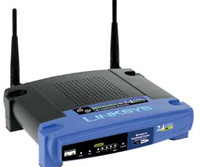Difference Between Router and Access Points

The Internet simply refers to interconnected PCs. It is through the internet that we can view web pages, get information and send e-mails to other PCs. So, if we want to set-up a similar small network within our home, office, or school, we can use cables to connect our PCs. The twisted-pair and co-axial cables are essential for this kind of network. But what if we want to connect to PCs that are futher away, or in other countries?
Certainly we cannot use hundreds of cables that are crossing the ocean anymore. So this is where the router (wireless) and access points become necessary.
A Router is a device used to route or direct messages and information between computers. Routers connect by wire or radio signals. It is the router’s job to make sure the messages arrive at the correct destination. The router looks at the IP address just like our home address to send the messages. It is also the router’s job to make sure the messages or information will not spill to other computers and prevent traffic.
The ability to connect multiple computers to the internet is one of the main features of a router. If there are multiple computers connected to the router, the router uses NAT (Network Address Translation) protocol, which gives your computer a private IP address. Routers also act as a DHCP (Dynamic Host Configuration Protocol) server. When you have DHCP server, it will assign a dynamic IP address to your computer, every time your computer is started-up.
On the other hand, an Access Point is not really a device. It is just a part of a wireless network that allows devices to access the internet. Routers can be made an access point. Access Points are interconnection points, or paths, that tie all the internet access providers together. It is used to connect wireless clients to LANs. They don’t really route computers, but they can bridge computers. That’s why they are typically used for home and small business offices.
Just like Routers, Access Points also contain security softwares, such as WEP, WPA, 8021x and TKPI, but they don’t have traffic management like routers. Access Points also do not have NAT, because that would just add an unnecessary layer to the network. To make it simple, Access Points are just like doorways, allowing a user to enter into other computers.
Summary:
1. A router is a device used to direct messages to and from computers, while Access Points are interconnection points that bridge computers.
2. Only the router has a traffic management function, allowing a free-flow of messages and information between computers.
3. Only the router can act as a DHCP server.
4. Routers and Access Points feature the same security softwares, such as WEP, WPA, 8021x and TKPI, but only routers uses NAT protocol.
- Difference Between EIDE and SATA - February 3, 2010
- Difference Between HTM and HTML - January 27, 2010
- Difference Between Grey and White Matter - January 27, 2010

Forget web 2.0……….. This portal (Difference Between.net) is the most useful, valuable and productive (and lucid) for me, my students, and for all who are FORTUNATE enough to locate/discover it on the W3.
You don’t know what help you can offer to the academics and to the whole society………
I hope, you will never close it.
Rank = Wikipedia
Rupak
Assistant Professor
Very useful article. The “difference between” is some thing which we often land up /look for. This site can be pretty useful and most watched, if the language/presentation is simple, and illustrated using more examples.
I like the content and also the summary at the end of article.
Continue your efforts on extending the site, in near furture, this site could become another wiki…